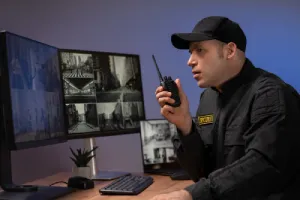Using PA, Radio, and Emergency Communication Systems
In a Security Control Room (SCR), communication is your most powerful tool. Whether you are using the Public Address (PA) system to calm a crowd, the radio to coordinate officers, or emergency channels to contact the authorities, your ability to use these systems confidently and professionally defines how effectively incidents are managed.
Every transmission, broadcast, or message you send represents your organisation, and it must meet the standards set by SIA, ACS, BSI, and NSI for accuracy, clarity, and control. In the high-pressure environment of a control room, communication systems are not just equipment, they are lifelines.

Why Effective Communication Systems Matter
PA, radio, and emergency systems keep the control room connected to the outside world. They allow instant communication, support rapid decision-making, and help protect lives.
Key Functions of Communication Systems:
PA Systems: Used to make public announcements or provide evacuation instructions during emergencies.
Radios: Facilitate real-time coordination between SCR Operators and ground staff.
Emergency Communication Systems: Connect directly with emergency services, such as fire, police, or medical teams.
These systems must always be used professionally and in compliance with BSI BS 7499 and NSI Guarding Gold standards, which require all security communication to be recorded, auditable, and clear.
Statistic to Know: According to ACS audit data, 65 percent of communication-related incidents could have been prevented or resolved faster with clear and timely radio or PA use.
Key Considerations for SCR Operators
Working with communication systems requires precision, discipline, and awareness. Every message you send should be purposeful, controlled, and logged accurately.
| System | Purpose | Best Practice |
|---|---|---|
| PA System | Make clear, calm announcements to staff or the public. | Speak slowly, use simple language, and avoid technical terms. |
| Two-Way Radio | Coordinate security teams and relay updates. | Use call signs, follow radio etiquette, and confirm messages. |
| Emergency Line | Notify fire, police, or ambulance services. | Give verified details only, and remain professional under pressure. |
Tip: Before using any communication channel, take one breath, think clearly, and then speak. Calm communication begins with a calm operator.
Using the PA System Professionally
The PA system is often your most public communication tool. It should be used only when necessary and always with clarity and authority.
Guidelines for Effective PA Announcements:
Stay Calm: Your tone influences how people react.
Be Clear: Speak slowly, pronounce words properly, and avoid long sentences.
Provide Instructions: Tell people what to do, not just what’s happening.
Avoid Panic Phrases: Never say “don’t panic”, it can cause the opposite effect.
Repeat When Needed: If an announcement is critical, repeat it every few minutes for consistency.
Example:
“Attention all staff, please proceed calmly to your designated assembly points. Security teams are managing the situation, and further updates will follow shortly.”
This message is calm, factual, and compliant with SIA and ACS communication expectations.
Radio Communication: The Control Room Lifeline
The radio is your fastest and most reliable method of communication during an incident. Professional radio use ensures that the entire team operates as one coordinated unit.
Radio Best Practices:
Use Call Signs: Always identify yourself and who you’re calling.
Keep It Short: Be concise, long messages can cause confusion.
Acknowledge Messages: Confirm receipt of all important transmissions.
Stay Professional: No slang, jokes, or emotional language.
Log Everything: Record all critical messages, including times and responses.
Example Radio Exchange:
“Control to Alpha One, confirm fire alarm activation in Zone 3.”
“Alpha One to Control, confirmed, alarm panel shows Zone 3 triggered, investigating.”
Tip: In stressful moments, your radio voice should be steady and controlled, it reassures the team and keeps communication efficient.
Emergency Communication Systems
Emergency systems connect the control room directly with responders or external authorities. These may include red-line phones, digital panic systems, or monitored alarm connections.
When Using Emergency Channels:
Verify Before Reporting: Confirm incidents before escalating.
Be Precise: Provide location, nature of the incident, and any hazards.
Stay on the Line: Remain connected until instructed otherwise.
Log the Call: Record the time, name of responder, and summary of the conversation.
Follow Up: Continue monitoring until the situation is resolved.
Example:
“This is the Security Control Room at Greenfield Centre reporting a confirmed fire alarm activation in Zone 4. The site has been evacuated, and fire service access is clear.”
Real-World Example: Clarity Saves Time
At a busy stadium in Manchester, a false alarm triggered during a football match. The SCR Operator immediately used the radio to confirm the cause while broadcasting a calm PA message to reassure fans.
“Attention all guests, our systems have detected an alert which is being investigated. Please remain seated until further instruction.”
Within three minutes, the issue was identified as a sensor fault, and the event continued safely. The operator’s clear communication prevented panic among thousands of spectators, a textbook example of SIA and ACS compliant communication under pressure.
Building Confidence with Communication Systems
Confidence with PA, radio, and emergency systems comes from familiarity and practice. Regular drills, scenario-based training, and equipment checks ensure you can communicate effectively when it matters most.
Key Habits to Build:
Test all communication devices at the start of each shift.
Keep spare batteries and cables ready.
Use role-play scenarios to practise emergency messages.
Review communication logs during debriefs to identify improvements.
Statistic to Remember:
Sites that conduct monthly communication system tests report 45 percent fewer critical response delays, according to NSI performance reviews.
Communicating with Control and Confidence
Using PA, radio, and emergency systems isn’t just about pressing buttons, it’s about leadership, precision, and professionalism. The way you communicate determines how effectively your team responds and how calmly others react.
Remember:
Speak clearly, stay composed, and always follow procedure. Your communication reflects the discipline and standards of the UK security industry. As an SCR Operator, your voice is the steady guide in uncertain moments, clear, calm, and compliant with SIA, ACS, BSI, and NSI expectations.

